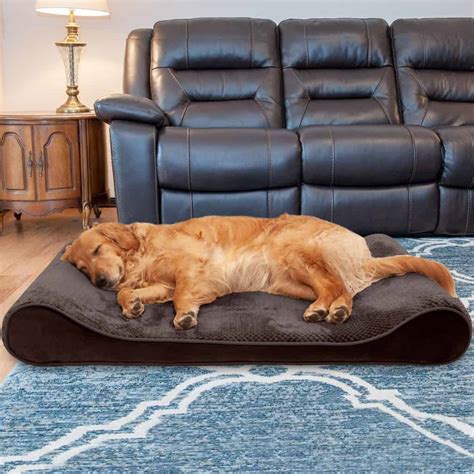Our furry friends deserve a cozy and secure haven to rest their weary bodies. Dog beds are not just a luxury; they provide essential support and comfort for your beloved companion. However, finding the perfect placement and layout for your dog’s bed is crucial to ensure both their well-being and the optimal utilization of your living space.

Choosing the Right Location
1. Consider Your Dog’s Personality and Habits
Dogs are creatures of habit and often prefer a specific spot to nap or sleep. Observe your dog’s behavior and identify areas where they tend to congregate or sleep. This will give you a good starting point for choosing a bed location.
2. Provide a Quiet and Safe Zone
Dogs need a sense of security and privacy to relax. Place the bed in a quiet corner of the room, away from noisy appliances or high-traffic areas. Avoid areas where children or other pets may disturb them.
3. Ensure Accessibility and Comfort
Make sure your dog can easily access their bed. Avoid placing it on elevated surfaces or in cramped spaces. Ensure the bed is the appropriate size for your dog’s breed and weight.
Optimizing Space Efficiency
1. Utilize Vertical Space
In small apartments or homes with limited floor space, consider using vertical space. Opt for elevated dog beds or wall-mounted pet cots to save valuable square footage.
2. Choose Multi-Purpose Furniture
Invest in furniture that incorporates a built-in dog bed. This not only saves space but also adds a stylish touch to your living area.
3. Consider Corner Placement
Corners are often underutilized spaces in a room. Place your dog’s bed in a corner to maximize floor space while providing your pet with a cozy retreat.
Common Mistakes to Avoid
1. Placing the Bed in High-Traffic Areas
Avoid placing your dog’s bed in walkways or areas where they may be disturbed or accidentally stepped on.
2. Choosing a Bed That’s Too Small
A dog bed that is too small can restrict your dog’s movement and make it uncomfortable. Always choose a bed that is large enough for your dog to stretch out and relax.
3. Ignoring Dog Bed Maintenance
Regularly clean and maintain your dog’s bed to keep it hygienic and comfortable. Wash the bedding frequently and inspect the bed for any damage or wear and tear.
Top Dog Bed Placement and Layout Ideas
| Placement | Benefits | Drawbacks |
|---|---|---|
| Corner | Space-efficient, cozy and private | May block access to certain areas |
| Under a table or desk | Protected from drafts and provides a sense of security | May not be easily accessible for your dog |
| In a hallway | Offers a central location and easy access | May be too noisy or drafty |
| Next to a window | Provides natural light and a calming view | May be too cold or hot depending on the season |
FAQs
1. How often should I wash my dog’s bedding?
Wash your dog’s bedding every 1-2 weeks to prevent the accumulation of bacteria and allergens.
2. What size bed is best for my dog?
Measure your dog from nose to tail and add 6-12 inches to determine the ideal bed length. For width, measure your dog’s height and add 2-4 inches.
3. Where should I place my dog’s bed if I live in a small apartment?
Consider using vertical space by opting for an elevated dog bed or a wall-mounted pet cot. Utilize corners or invest in multi-purpose furniture that incorporates a built-in dog bed.
Future Trends and Improvement
As technology advances, dog bed placement and layout will become even more flexible and adaptable. Smart dog beds with built-in sensors can monitor your pet’s sleep patterns and adjust temperature accordingly. Automated cleaning systems will make bed maintenance a breeze.
By understanding the importance of proper dog bed placement and layout, you can create a comfortable and safe haven for your furry friend while optimizing space efficiency in your home. Remember to consider your dog’s individual needs and habits, and always prioritize their well-being and comfort.





















